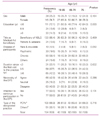References
1. Shin HW, Shin YS, Whang DK, You WS, Choi KC, Lim SJ. Monitoring the designated medical institution program for Medical Aid beneficiaries 2008. Seoul: Korea Institute for Health and Social Affairs;
2. National health insurance statistics [Internet]. National Health Insurance Corporation; Health Insurance Review & Assessment Service 2001-2010. Seoul: National Health Insurance Corporation; Health Insurance Review & Assessment Service; Available from:
http://www.bokjiro.go.kr/data/statusList.do.
4. Shin HW, Shin YS, Yoon SJ, Kim S, Choi JS. Introduction plan of the designated medical institution program and co-payment system for Korean Medical Aid beneficiaries 2007. Seoul: Korea Institute for Health and Social Affairs;
5. Kim S, Choi JS, Ju JS, Choi MY, Yang JH, Chae JM. Evaluation of the effect and the improvement plan of the designated medical institution system for Medical Aid beneficiaries 2010. Seoul: Health Insurance Review & Assessment Service;
6. Lee WH. Development plan for medical service and health maintenance of Medical Aid beneficiaries [dissertation] 2006. Seoul: Hanyang University;
7. Kim ES, Nam JJ, Kim MY, Ko IS, Lee DM, Kim KS, Choi JS, Park HJ, Shin SM, Lee SH, Yang IS. Status that long-term users of medical aid use medical service, and its improvement plan 2007. Seoul: Ministry of Health and Welfare;
8. Samarasekera U. Margaret Chan's vision for WHO. Lancet 2007. 3691915–1916.
9. Ko IS, Lee TW, Lee KJ, Lee JL, Choi JS, Lee SK, Kim JA, Lee MR. Case management networks for effective management of health care in the low income people 2006. Seoul: Ministry of Health and Welfare;
10. Lee JH, Choi YJ, Sung NJ, Kim SY, Chung SH, Kim J, Jeon TH, Park HK. Korean Primary Care Research Group. Development of the Korean primary care assessment tool-measuring user experience: tests of data quality and measurement performance. Int J Qual Health Care 2009. 21103–111.
11. National Health Insurance Corporation. Effectiveness assessment in primary care 2008. Seoul: National Health Insurance Corporation;
12. Choi YG, Kim K, Choi YJ, Sung NJ, Kim J, Park JH, Hong SK, Lee JH. Korean Primary Care Research Group. Patient assessment of primary care of health cooperative clinics in South Korea. Korean J Fam Med 2010. 31765–777.
13. Sung NJ, Suh SY, Lee DW, Ahn HY, Choi YJ, Lee JH. Korean Primary Care Research Group. Patient's assessment of primary care of medical institutions in South Korea by structural type. Int J Qual Health Care 2010. 22493–499.
14. Park JH, Kim KW, Sung NJ, Choi YG, Lee JH. Korean Primary Care Research Group. Association between primary care quality and health behaviors in patients with essential hypertension who visit a family physician as a usual source of care. Korean J Fam Med 2011. 32104–111.
15. Jung JW, Sung NJ, Park KH, Kim SW, Lee JH. Patient's assessment of community primary and non-primary care physicians in Seoul city of South Korea. Korean J Fam Med 2011. 32226–233.
16. Care coordination measures atlas [Internet]. Agency for Healthcare Research and Quality 2010. cited 2011 Dec 10. Rockville (MD): Agency for Healthcare Research and Quality; Available from:
http://www.ahrq.gov/qual/careatlas/careatlas.pdf.
17. Starfield B, Shi L, Macinko J. Contribution of primary care to health systems and health. Milbank Q 2005. 83457–502.
18. Starfield B. Primary care: balancing health needs, services, and technology 1998. New York: Oxford University Press;
19. Lee JH, Choi YJ, Volk RJ, Kim SY, Kim YS, Park HK, Jeon TH, Hong SK, Spann SJ. Defining the concept of primary care in South Korea using a Delphi method. Fam Med 2007. 39425–431.
20. Cho HJ. The prospect of QA in primary care. J Korean Acad Fam Med 1994. 15847–856.
21. Quality and outcomes framework: online GP practice results database [Internet] 2011. cited 2011 Dec 13. London: The Health and Social Care Information Centre; Available from:
http://www.qof.ic.nhs.uk/.
24. DeVoe JE, Saultz JW, Krois L, Tillotson CJ. A medical home versus temporary housing: the importance of a stable usual source of care. Pediatrics 2009. 1241363–1371.
25. Blewett LA, Johnson PJ, Lee B, Scal PB. When a usual source of care and usual provider matter: adult prevention and screening services. J Gen Intern Med 2008. 231354–1360.
26. O'Malley AS, Mandelblatt J, Gold K, Cagney KA, Kerner J. Continuity of care and the use of breast and cervical cancer screening services in a multiethnic community. Arch Intern Med 1997. 1571462–1470.
27. Kim JH, Cho HJ. Effects of having regular source of care on preventive services and disease control. J Korean Acad Fam Med 2007. 28278–285.
28. Schoen C, Osborn R, Huynh PT, Doty M, Davis K, Zapert K, Peugh J. Primary care and health system performance: adults' experiences in five countries. Health Aff (Millwood) 2004. Suppl Web ExclusivesW4-487–W4-503.
30. Jung YH. A report on the Korea Health Panel Survey: health care utilizations and out-of-pocket spending. Health Welf Policy Forum 2011. 17964–82.



